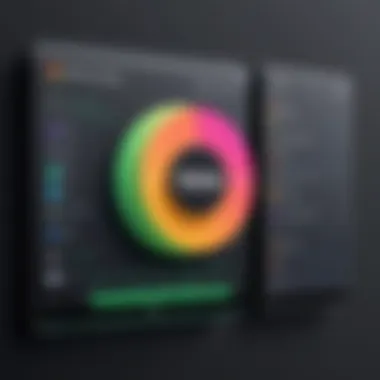Transforming Live Pictures into Engaging Videos


Intro
In the modern digital sphere, the way we capture and convey moments has evolved dramatically. The transformation of live pictures into dynamic videos represents a significant leap in visual storytelling. Applications that facilitate this process are gaining popularity among users seeking innovative ways to share experiences. This surge is fueled by advancements in technology and an enhanced understanding of user needs.
The tools available today enable individuals to create engaging content that resonates with audiences. Users can easily turn still images into vibrant video clips that capture the essence of a moment. Furthermore, the applications often come equipped with features that add layers of creativity and personalization, making the final product more appealing.
As the boundaries of digital content creation continue to expand, understanding how these applications function is crucial. This exploration will delve into key aspects of various apps that can convert live pictures into videos, offering insights into their specifications, unique features, and practical usage. By comprehensively examining these tools, readers can make more informed choices in a landscape where image and video manipulation play a central role.
"The journey from picture to video is not merely about capturing a moment; it’s about enhancing storytelling and connection through technology."
In the following sections, we will unpack the core technologies that drive these applications and assess their design, build quality, and usability. This guide aims to provide clarity to tech-savvy individuals eager to explore the innovations shaping their digital experiences.
Prelims to Live Pictures and Video Conversion
In recent years, the convergence of photography and videography has transformed how we express ourselves visually. The emergence of live pictures as a unique medium allows users to engage with their memories in an interactive manner. This article delves into the nuances of live pictures and the subsequent need to convert them into dynamic videos. Understanding this transformation is crucial as it provides insight into both the technological advancements and the enhanced storytelling capabilities available today.
Defining Live Pictures
Live pictures refer to still images that possess a short duration of motion, typically captured in a format like Apple's Live Photos or Google’s Motion Photos. These images provide a lively representation of a moment, allowing small snippets of visual storytelling without the full commitment of a video. The importance of defining live pictures lies in their capacity to evoke emotional responses. They blend the appeal of photography's stillness with the dynamism of video, creating a rich visual narrative.
The Evolution of Digital Media
The landscape of digital media has seen substantial evolution over the past decade. As consumer expectations have increased, so too has the demand for more engaging content. Initially, images served the sole purpose of capturing a moment. However, as technology advanced, platforms emerged that enable users to seamlessly integrate motion into still images. This evolution has shifted societal norms regarding content creation and sharing, emphasizing the necessity for versatile applications that transform live pictures into compelling videos. As users discover new tools to amplify their creativity, the interplay of images and videos continues to redefine digital storytelling.
"The way we visualize our memories has evolved significantly, enhancing both the experience and narrative quality of digital media."
To harness the potential of live pictures fully, embracing video conversion technology is essential. This article will guide you through innovative apps that provide these capabilities, revealing how they can significantly enhance visual expression.
The Need for Video Conversion from Live Pictures
In an era where visual communication reigns supreme, the ability to convert live pictures into dynamic videos has become increasingly relevant. The demand for such tools stems from a variety of factors, each amplifying the need for effective video conversion in both personal and professional contexts. These transformations not only elevate artistic expression but also enhance information delivery and engagement.
Enhancing Visual Storytelling
Visual storytelling is a powerful technique that combines imagery, sound, and narrative to convey messages. With live pictures, creators have a unique opportunity to weave compelling tales through the medium of video. Engaging narratives can be enriched in several ways:
- Dynamic Content Presentation: Videos allow for a more fluid presentation of ideas and emotions. Live pictures, when animated or overlaid with effects, can evoke emotions that still images cannot.
- Attention Retention: Videos naturally capture and retain the audience's attention longer. This is crucial in an age where distractions are abundant and fleeting.
- Stronger Branding Opportunities: In marketing, brands can create distinct identities through moving visuals. Videos can encapsulate a brand's message more effectively than static images.
In summary, transforming live pictures into videos serves to enhance visual storytelling by providing depth, emotional connection, and branding potential.
Utilizing Social Media Platforms
Social media has transformed the landscape of content consumption. As individuals and brands seek to engage audiences, the ability to share compelling video content derived from live pictures becomes a strategic advantage. Here are a few aspects that illustrate the need for video conversion in this domain:
- Platforms Favoring Video Content: Social media giants, like Facebook and Instagram, prioritize video content in their algorithms. Posts with videos receive significantly more engagement compared to those that feature still images.
- Short Attention Spans: Today's audiences tend to prefer quick, easily digestible content. Videos adapted from live pictures can succinctly deliver complex ideas and narratives without overwhelming viewers.
- Interactive Engagement: Video content allows for interactive elements such as polls, comments, and shares. This fosters community engagement and interaction, enhancing viewer loyalty.
The integration of live picture conversion into social media strategies is no longer optional; it’s essential for maximizing reach and interaction.
Overview of Popular Apps for Video Conversion


In the world of digital media, transforming static images into engaging videos is a powerful process. The demand for dynamic content is ever increasing, making app development essential. Knowing the available options is paramount for users aiming to leverage live pictures effectively. This overview highlights major video conversion apps and their unique offerings, providing insights to help you navigate the available tools.
Feature Comparison of Top Apps
Each app focuses on specific features that users prioritize. Below are key aspects to consider when comparing popular apps for video conversion:
- Ease of Use: Many users seek a straightforward experience. Intuitive interfaces allow for quick navigation and efficient operation.
- Export Quality: The output video quality can vary. Some apps support 4K resolution while others limit to 1080p, affecting user satisfaction.
- Customization Options: Apps like Adobe Premiere Rush allow more detailed editing, giving users the tools to apply personal touches.
- Social Media Integration: Certain apps are designed to export directly to platforms like Instagram or Facebook, streamlining the sharing process.
These features greatly influence the user experience and ultimately the success of the video created.
User Experience and Interface Design
User experience is a critical aspect of any video conversion app. A well-designed app can encourage more frequent use and enhance overall satisfaction. Some factors to assess include:
- Layout Clarity: A clean and navigable layout helps users find tools quickly. Apps like InShot are noted for their clean interface.
- Response Time: How quickly does the app process images? Fast response times lead to higher user satisfaction.
- Accessibility of Features: Important tools should be readily available without deep navigation.
Moreover, user feedback often provides valuable insight into design efficacy. User reviews frequently highlight elements that enhance or detract fromtheir experience.
As the landscape of technology evolves, staying abreast of innovative applications becomes crucial. Exploring popular apps for video conversion empowers users to select tools that meet their unique needs and elevate their digital storytelling.
Innovative Features of Video Conversion Apps
Innovative features in video conversion apps play a vital role in enhancing the user experience. These elements not only improve the functionality of the apps but also ensure that users achieve high-quality, aesthetically pleasing videos from their live pictures. Utilizing these features can significantly streamline the process of video creation, making it more accessible to a broad audience.
AI Integration
AI integration in video conversion apps is a groundbreaking advancement. It offers users powerful tools to manipulate their media effortlessly. Through machine learning algorithms, these apps can analyze images and suggest optimal edits or transformations. For instance, they might automatically stabilize shaky videos or enhance colors without user intervention.
The benefits of AI in this context are substantial:
- Automation: Many processes that previously required intricate manual adjustments are now automated, saving users time and effort.
- Precision: AI algorithms can provide more accurate results than manual editing, ensuring that the final product meets user expectations.
- Intelligence: With continued learning, AI can adapt to users' preferences, providing personalized editing solutions over time.
"With AI, video editing transitions from a skill-based task to an intuitive engagement. Users save time and achieve professional-level results with ease."
Filters and Effects
Filters and effects have become essential components of video conversion apps. These features allow users to add visual appeal to the videos generated from live pictures. They range from simple color adjustments to complex overlays and animations that can significantly transform the final output.
Key considerations when using filters and effects include:
- Customization: Users can tailor their videos to match their desired aesthetic, whether for personal archives or professional presentations.
- Trendy Options: Many apps stay updated with the latest trends in visual effects, keeping the content relevant and engaging for viewers.
- User-Friendly Interfaces: The best apps are designed so that even those without technical backgrounds can navigate and implement filters easily.
The right combination of these effects can elevate the quality of the video, making it more engaging for its audience.
Music and Sound Integration
The integration of music and sound is another critical aspect of video conversion apps. Adding audio elements can enhance the storytelling aspect of the videos, making them more immersive for viewers. Users can select from royalty-free tracks, import their music, or even use voiceovers to personalize their content further.
Some important points about this feature include:
- Diverse Libraries: Access to a range of music and sound effects can cater to different tastes and themes.
- Syncing Options: Many apps allow users to synchronize audio perfectly with visuals, creating a seamless experience.
- Editing Capabilities: Users can edit audio tracks to ensure that the background music complements rather than overwhelms the visuals.


In summary, the innovative features of video conversion apps not only enrich user experience but also elevate the final product.
Understanding how to leverage these capabilities can help users maximize their creativity, allowing them to transform live pictures into dynamic and engaging videos.
Technical Aspects of Video Creation
Understanding the technical aspects of video creation is crucial for users who wish to transform live pictures into dynamic videos. This knowledge empowers individuals to make informed decisions regarding the tools they use and the quality of the output. Importantly, technical considerations range from file formats to rendering speeds, each playing a pivotal role in the overall user experience.
File Formats and Quality Considerations
File formats are fundamental in video creation. Choosing the right format impacts both quality and compatibility with devices and platforms. Common formats include MP4, AVI, and MOV. Each has unique traits.
- MP4: Highly versatile, suitable for web use.
- AVI: Provides excellent quality but larger file sizes.
- MOV: Often used for Apple devices; it balances quality and compression well.
Quality considerations also extend to resolution and frame rates. Higher resolutions yield crisper visuals, while frame rates affect motion smoothness. Standard frame rates like 30fps are common, but higher rates such as 60fps can enhance the perception of motion in certain contexts. Adapting these choices to the intended use can lead to more effective video presentations.
Rendering and Processing Speeds
Rendering and processing speeds can significantly influence the user experience. This pertains to how quickly the software can convert live pictures into videos. Optimized software can minimize lag and deliver timely output, which is essential for the fast-paced nature of digital content creation.
Key aspects to consider include:
- Hardware Requirements: Systems need adequate processors and memory to handle complex tasks efficiently.
- Background Processes: Running multiple applications can slow down video processing; focusing system resources on the video app can expedite rendering.
- Software Optimization: Various apps offer different levels of optimization. Some may leverage GPU acceleration to boost performance.
In summary, understanding the nuances of these technical aspects positions users to maximize their experience in video creation, ensuring they achieve quality results tailored to their needs.
User Reviews and Feedback
User reviews and feedback play a crucial role in the decision-making process for anyone looking to convert live pictures into dynamic videos. As apps and technology evolve, understanding firsthand experiences can illuminate the strengths and weaknesses of various applications. This section provides insight into the significance of user feedback, ensuring readers can harness this information effectively.
Users often provide detailed reviews that cover usability, performance, and features of the apps. By reading diverse opinions, potential users can gauge how well an app meets their specific needs. This can include everything from the ease of navigation to the effectiveness of applied effects. Knowing what features stand out can guide choices, especially for those who prioritize high-quality outputs.
Moreover, reviews highlight common pain points. Understanding the challenges faced by others can help users set realistic expectations. This transparency can also spur developers to address shortcomings. By fostering a community around feedback, app creators can enhance the overall user experience, paving the way for innovation and improvement.
"User feedback is not just a reflection of satisfaction but a pathway to improvement in technology."
The integration of user feedback can lead to enhanced functionality. When developers actively consider and implement suggestions, it improves the product and fosters loyalty among users. This reciprocal relationship encourages consumers to provide constructive insights, further enriching the development process.
Success Stories from Users
Success stories can be compelling testaments to the effectiveness of live picture conversion apps. Users often share moments where their creative visions came to life, thanks to a specific application. These narratives demonstrate how such tools can transform personal and professional projects.
For example, a wedding photographer might recount how an app allowed them to create a stunning video montage from still images, capturing the essence of the event. Similarly, a YouTube creator could highlight how they use an app to turn their live streams into engaging highlight reels, increasing viewer engagement and retention.
These stories provide tangible evidence of how these applications elevate content and engage audiences.
Common Challenges Faced
Despite the benefits, users often encounter various challenges when using video conversion apps. Identifying these common issues can prepare new users for the possible hurdles they may face.
One prevalent issue is compatibility with different file formats. Some users may struggle to upload images that do not meet specific criteria set by the app, leading to frustration. Additionally, the processing speeds of the app can be a significant hurdle, especially for those dealing with larger projects. A slow processing time can hinder workflow, particularly in fast-paced environments where time is a critical factor.


Another common feedback area involves the learning curve. While some applications are user-friendly, others require a substantial amount of time to master. This can be discouraging for initial users who may be looking for quick results.
Lastly, there are concerns about customer support. Many users expect timely assistance when issues arise, yet this support is not always available or adequate. This can affect user satisfaction and ultimately impact the app's reputation.
By addressing these challenges, potential users can approach their app experience more prepared, fostering a more efficient and enjoyable video transformation journey.
Future Trends in Video Conversion Technology
The acknowledgment of future trends in video conversion technology is paramount in understanding the ongoing evolution of digital content. As the demand for more engaging and dynamic visuals increases, these trends will shape how users interact with their captured moments. Recognizing these technological advancements allows consumers to stay ahead in a rapidly changing digital landscape and enhances user experience in converting live pictures into videos.
One significant benefit of these trends is the potential for improved production quality. As technology progresses, users can expect higher resolutions, enhanced effects, and seamless integration of multimedia elements. These upgrades will be critical in a world dominated by social media where captivating visuals can significantly impact engagement and reach.
Additionally, considerations about compatibility with various platforms will become increasingly important. As more apps emerge, ensuring accessibility to a canvas of formats will allow users to distribute their creations effortlessly across social networks and other systems.
"The future of video conversion will focus on accessibility and quality, making it vital for creators to embrace available tools and options."
Emerging Technologies to Watch
Several technologies hold potential to redefine video conversion for live pictures. Among these innovations, artificial intelligence (AI) stands out. Machine learning algorithms can now analyze the content of photos, enabling apps to automate aspects of video creation like selecting transitions or syncing images with music. As AI continues to advance, we can expect even more intuitive interfaces to simplify the user experience.
Additionally, cloud computing is gaining traction. By leveraging the cloud for storage and processing, apps can enhance rendering speeds and improve collaboration among users. This means mobile devices do not always have to bear the processing load, making it quicker and more efficient to produce videos.
- Benefits of cloud computing in video conversion include:
- Faster rendering times by offloading tasks.
- Accessibility from multiple devices.
- Enhanced collaboration and sharing capabilities.
Impact of Virtual Reality and Augmented Reality
The integration of virtual reality (VR) and augmented reality (AR) into video conversion is transforming the way users perceive and create content. As these technologies evolve, they offer increasingly immersive experiences. While VR provides a simulated environment, AR allows integration of digital elements into real-world settings, enhancing the overall visual narrative.
The impact of these technologies is multifaceted. AR can allow users to add interactive elements to their videos, making the final product more engaging. For instance, users can superimpose graphics or animations directly onto live-action footage, revolutionizing how they share personal stories or business presentations.
Furthermore, as the toolsets for VR and AR become more accessible, we will likely see a new wave of creativity in video conversion. Users can engage with platforms such as Facebook and Instagram in unprecedented ways, where sharing dynamic visual experiences will set creators apart from the crowd.
As these trends unfold, understanding the capabilities and applications of both VR and AR will be essential for anyone passionate about transforming live pictures into video content.
Epilogue and Recommendations
The conclusion of this article is vital as it ties together the themes discussed and provides actionable insights for readers. As the landscape of digital media continues to evolve, understanding how to transform live pictures into engaging video content is becoming increasingly important. This process not only enhances visual storytelling but also caters to the growing demand for dynamic content in various online platforms.
Choosing the Right App for Your Needs
Selecting the right app for video conversion requires consideration of several factors. It is essential to evaluate your specific needs. Factors to consider include:
- User Interface: Look for applications with intuitive designs that facilitate easy navigation. A complicated interface can detract from your creative process.
- Feature Set: Different apps offer varying capabilities, such as AI integrations, filters, or sound effects. Ensure the app includes the functionalities you prioritize.
- Compatibility: The app should support the file formats you use most frequently. Check if it integrates well with devices you own, such as smartphones or computers.
- Support and Community: Apps with active user communities or customer support can enhance your learning experience. They provide valuable resources for troubleshooting and creative inspiration.
Ultimately, the right choice aligns with your skills and project goals. Take time to explore user reviews and try free trials when possible.
Staying Updated with Technology
Staying knowledgeable about the latest software and developments is crucial in today's fast-paced tech environment. New features and updates appear regularly. To remain competitive and creative in video production, consider the following strategies:
- Subscribe to Industry News: Follow tech blogs, podcasts, and forums like Reddit that focus on video editing and app development. Engaging with this content exposes you to trends and innovations.
- Participate in Online Communities: Joining platforms like Facebook groups or specialized forums allows for discussion with peers. Exchange tips and tricks or seek feedback on your work.
- Attend Workshops or Webinars: Continual learning helps one stay adept at using various tools. Whether through online classes or local workshops, these experiences can deepen your skills.
By maintaining awareness of existing and emerging technologies, you ensure the tools you use remain relevant and effective for your creative endeavors.
It is not just about creating content but creating it with tools that empower your vision.







